Abstract
A sample of African-American and white young adults were classified as having multiple sex partners or one sexual partner. Subjects with multiple sexual partners were more likely to use drugs and practice risky sexual behaviors such as having anal intercourse, having sexual experiences with a prostitute, and having a history of gonorrhea (P < .001) and genital warts (P < .01). Additional analyses were conducted to determine African-American versus white differences in risky sexual behaviors. Results indicated that whites in the multiple partners and single partner groups were more likely to engage in anal and oral sex, while African Americans were more likely to have sex with prostitutes. Attitudes about the use of condoms differed significantly by multiple partner status (P < .004) and gender (P < .007), but not ethnicity. However, angry reactions about the use of condoms occurred more with African Americans (P < .003) and males (P < .05) than with whites or females. While whites reported a greater use of drugs and a significantly higher level of knowledge about HIV/AIDS, African Americans reported a significantly greater perception of risk for being exposed to human immunodeficiency virus (HIV)/acquired immunodeficiency syndrome (AIDS) (P < .01) and significantly more gonorrhea (P < .10), syphilis (P < .05), and HIV/AIDS (P < .05). No whites in our sample were treated for syphilis nor had they tested positive for HIV/AIDS. On the other hand, 4.5% of the total sample of African Americans reported testing positive for HIV/AIDS. Finally, the results from discriminant analysis indicate that a large number of variables significantly discriminate between subjects who engage in risky sexual behaviors and those who do not. Although there is some similarity in the variables for African Americans and whites, there was tremendous variability between the ethnic groups in the factors that predict risky behaviors. These findings are discussed with reference to the need to develop HIV/AIDS prevention programs for African Americans that are based on data derived from African-American populations rather than from black versus white comparison studies.
Full text
PDF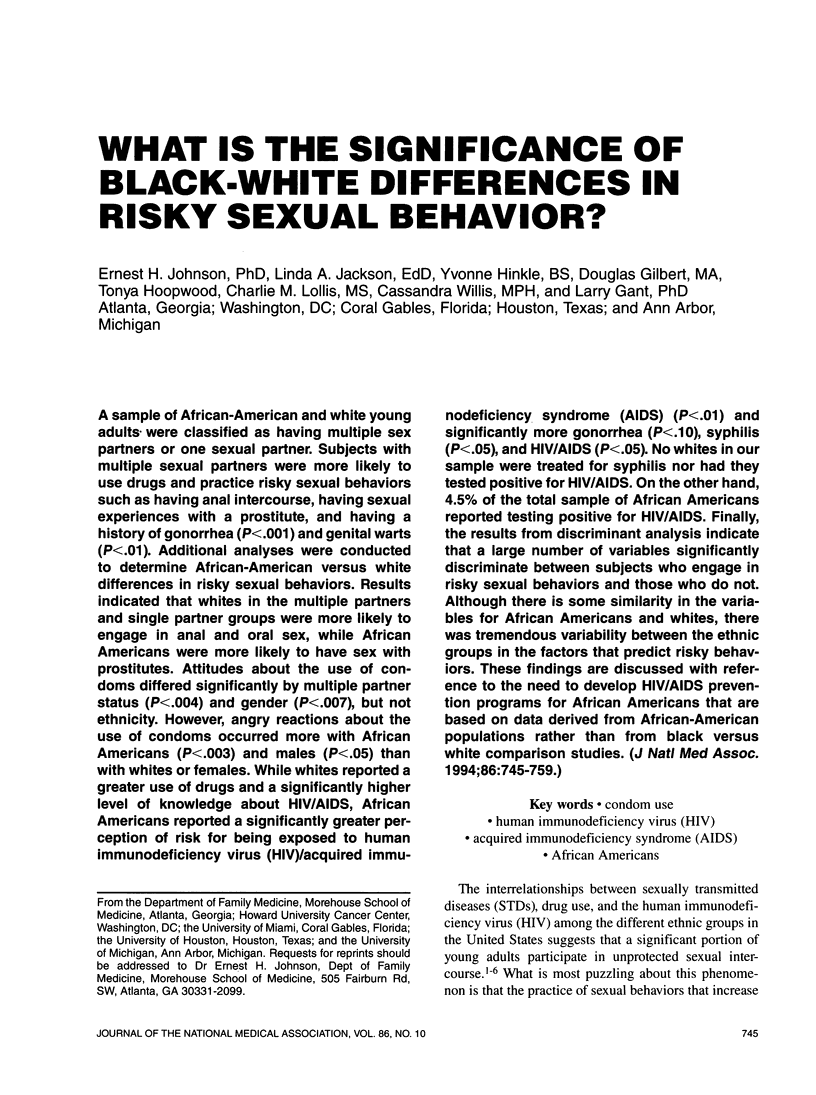
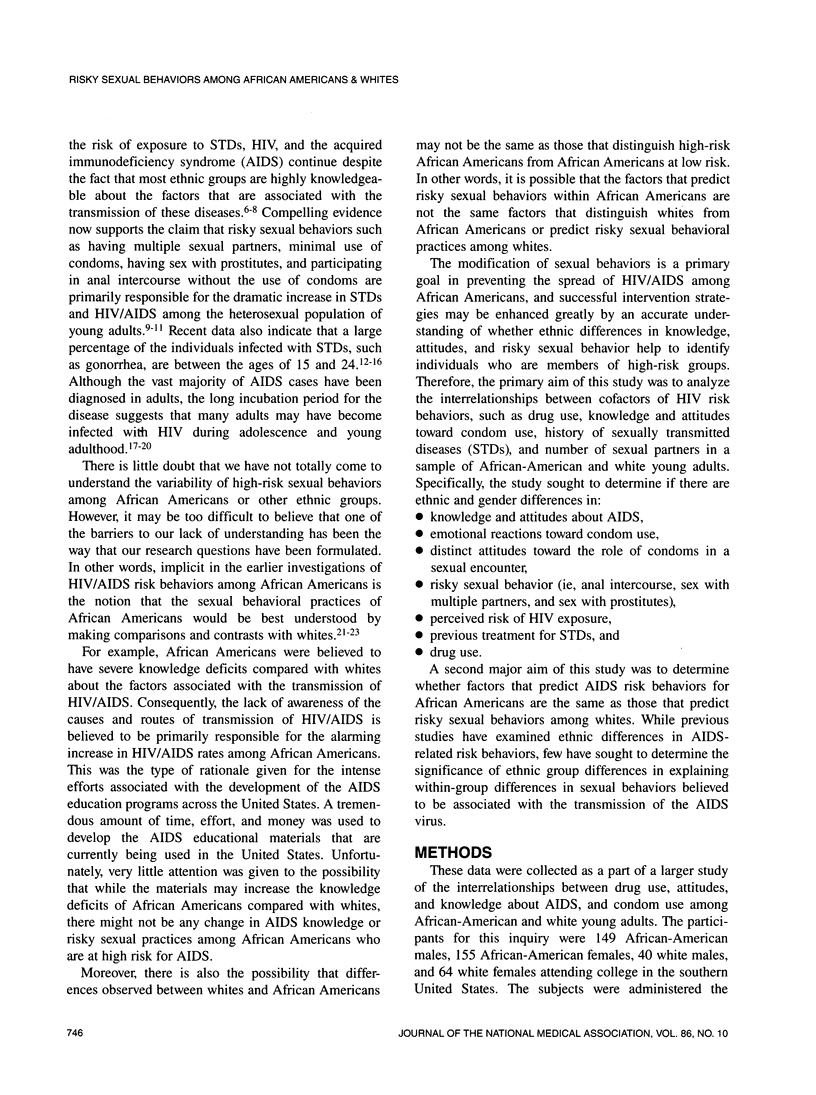
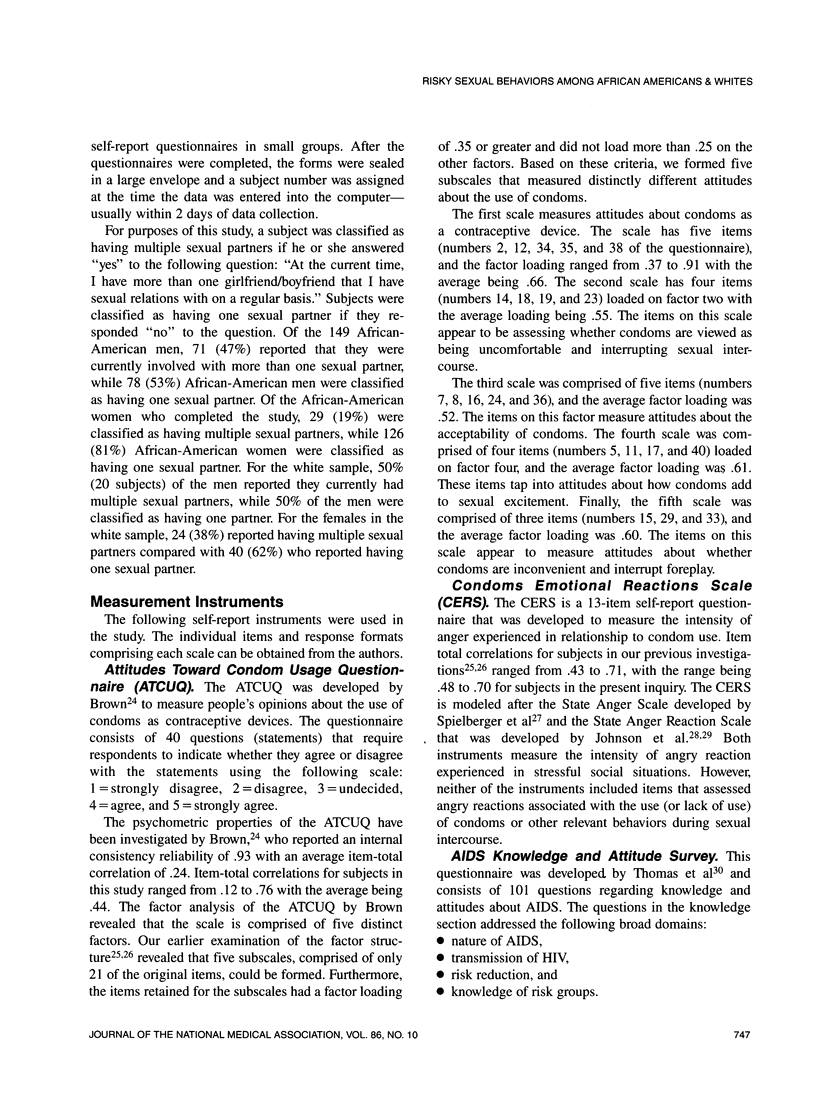
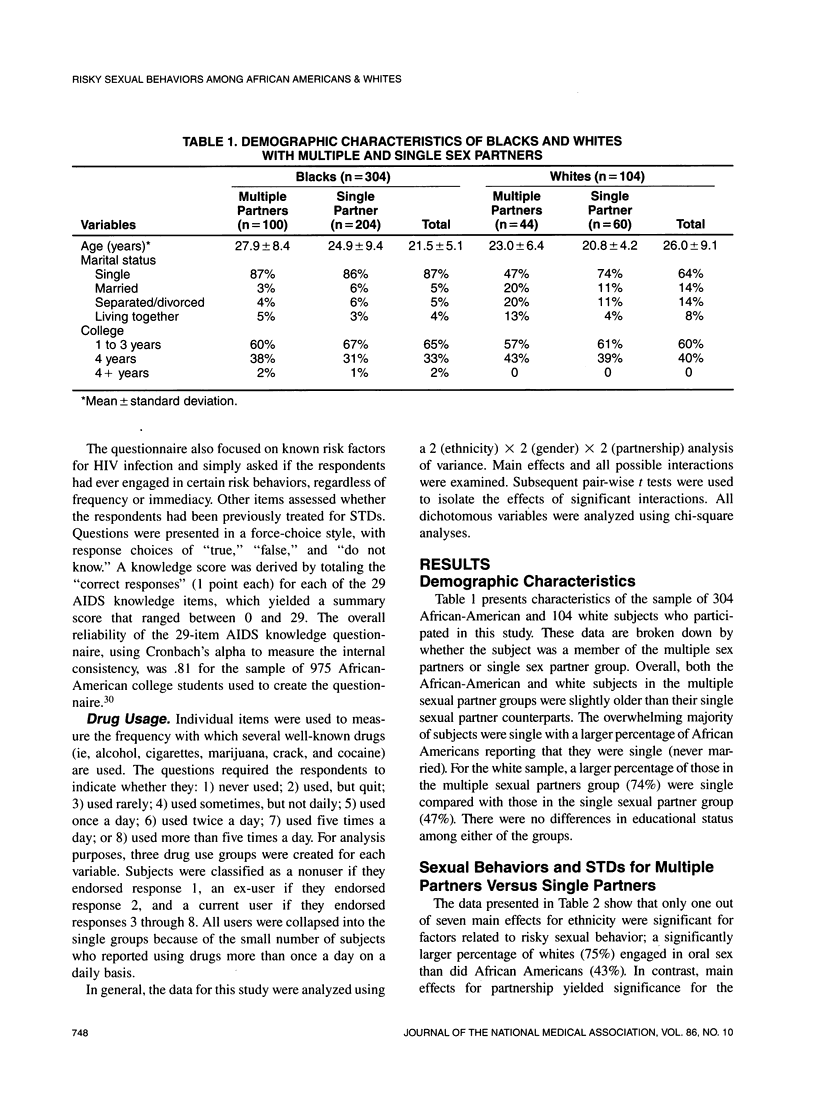
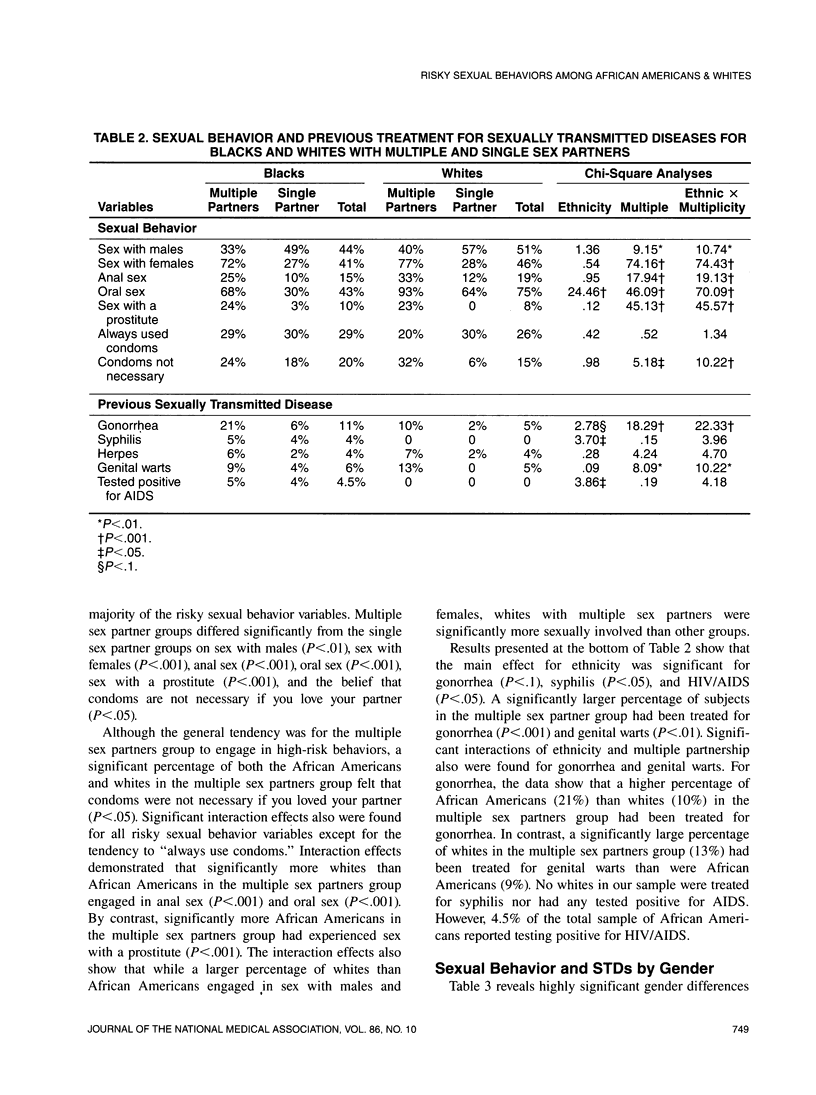
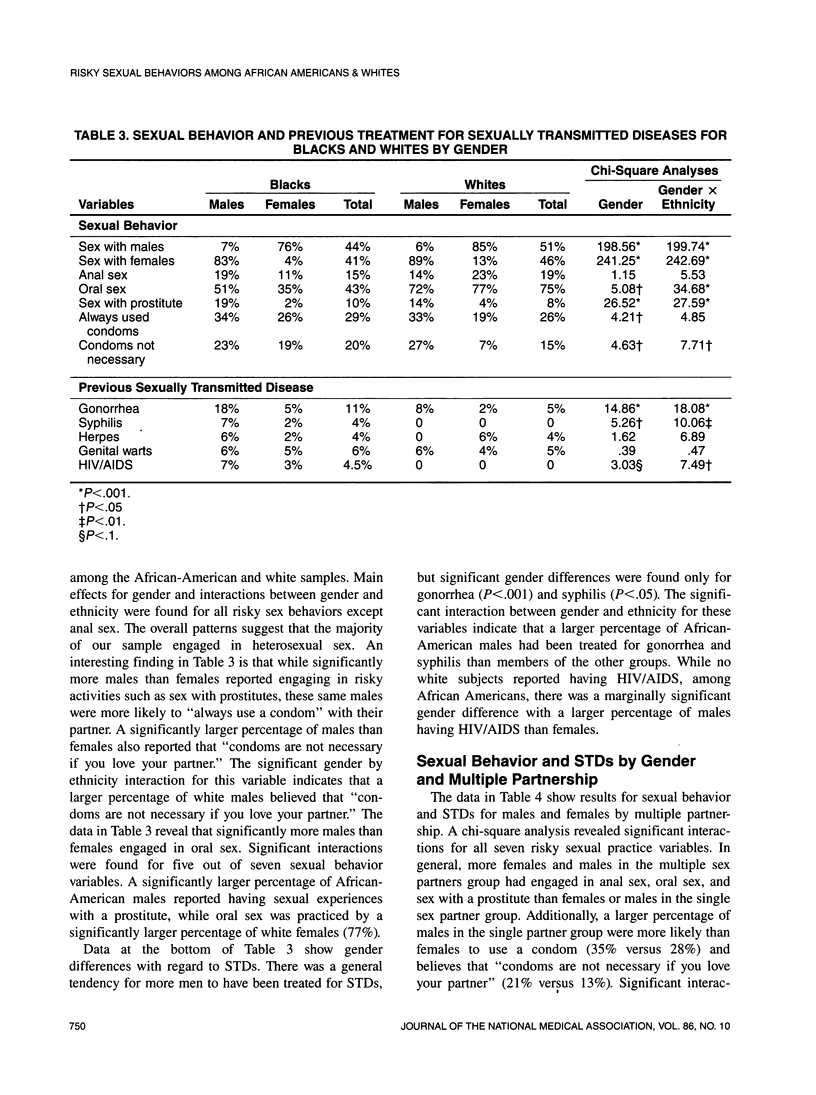
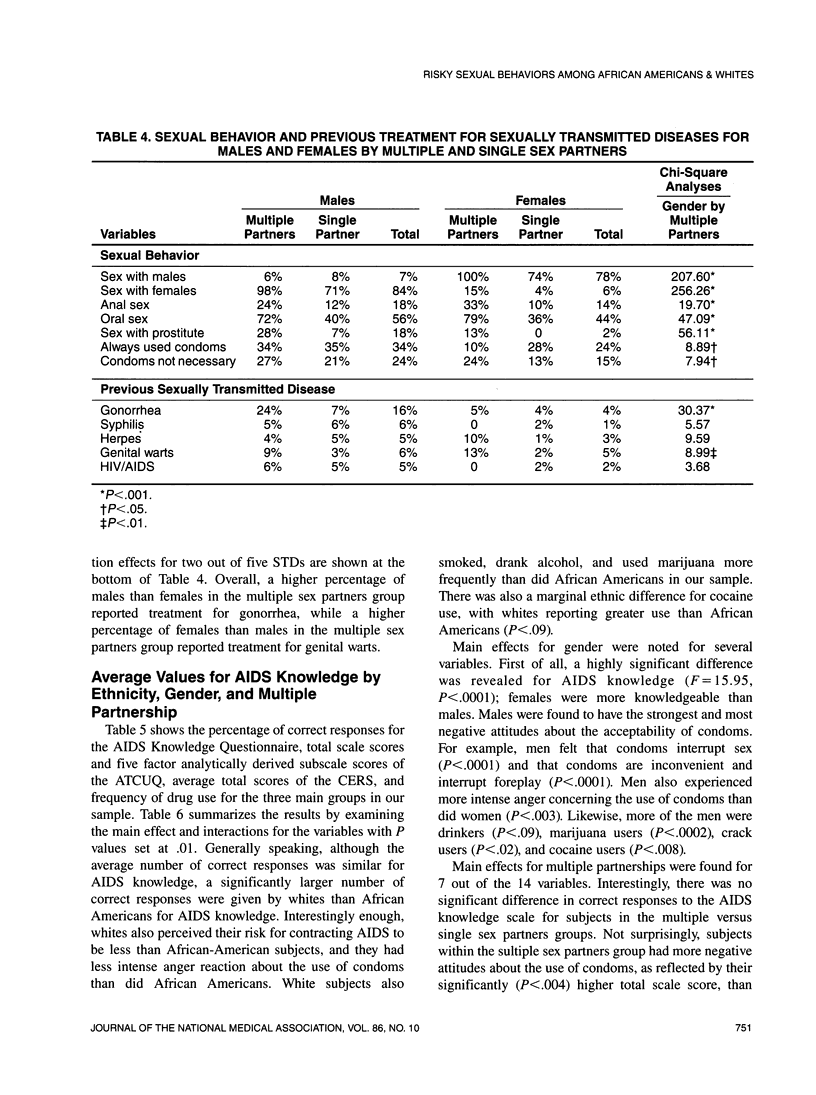
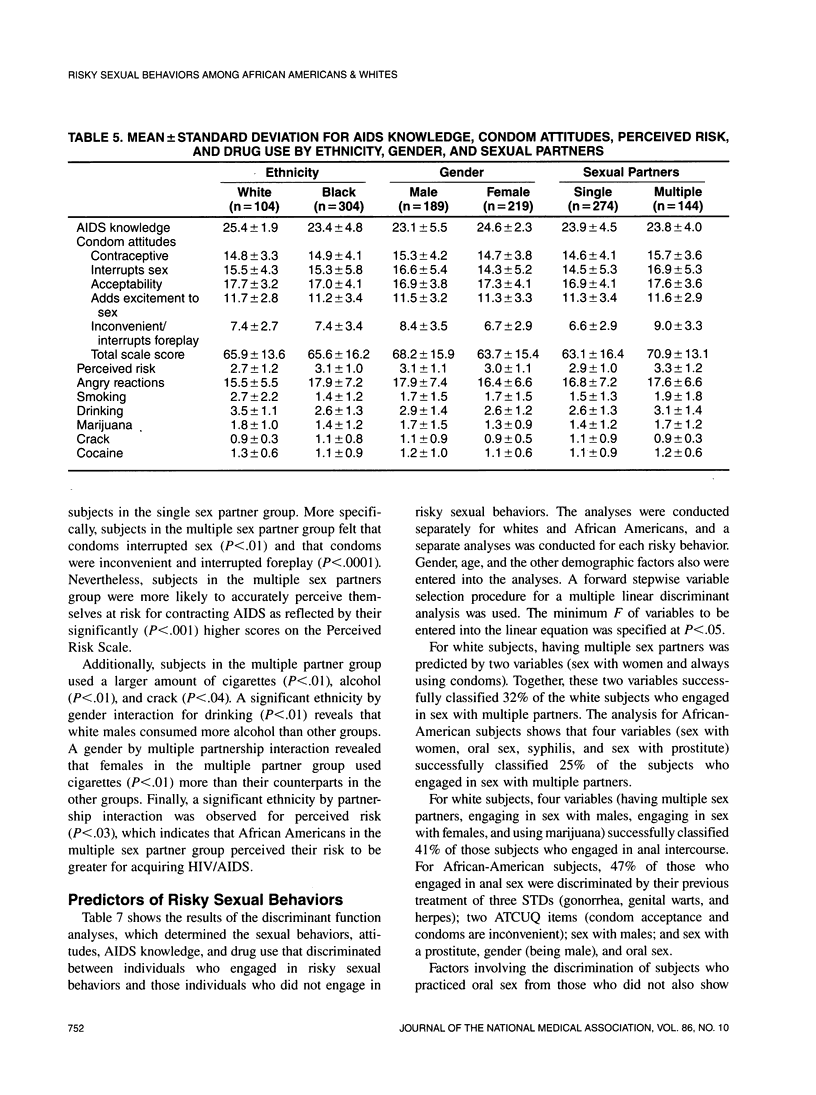
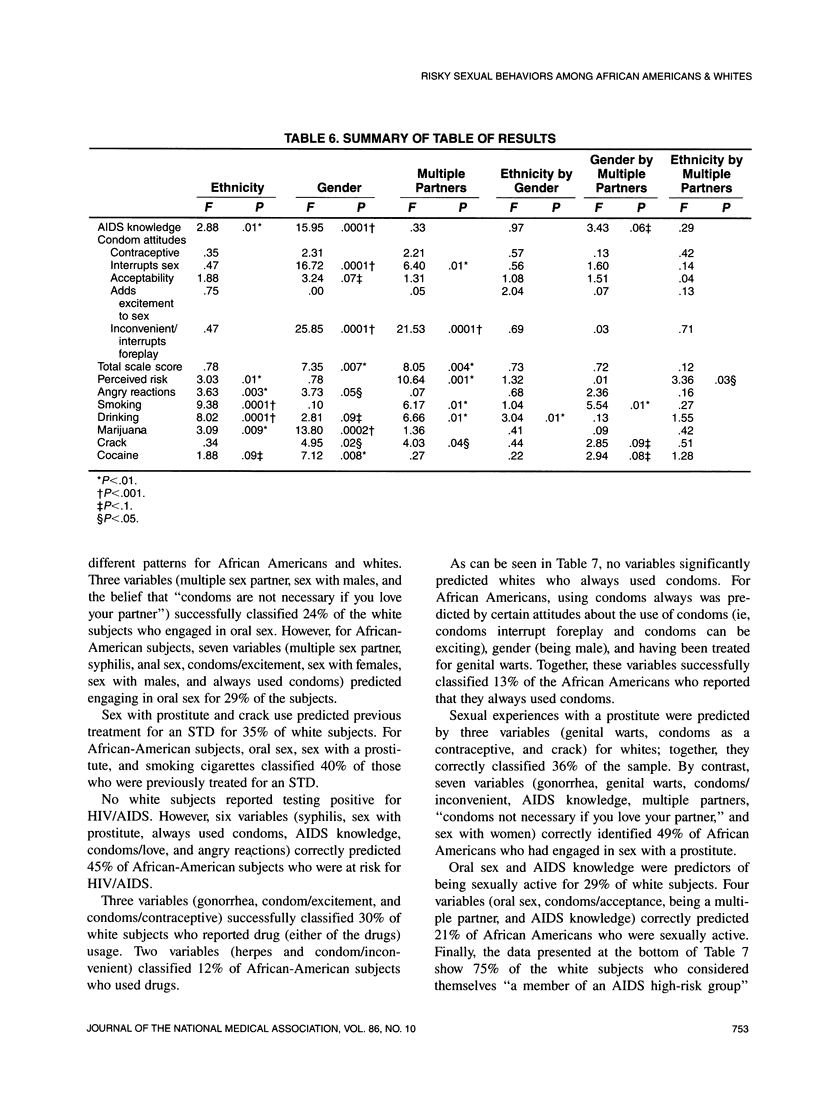
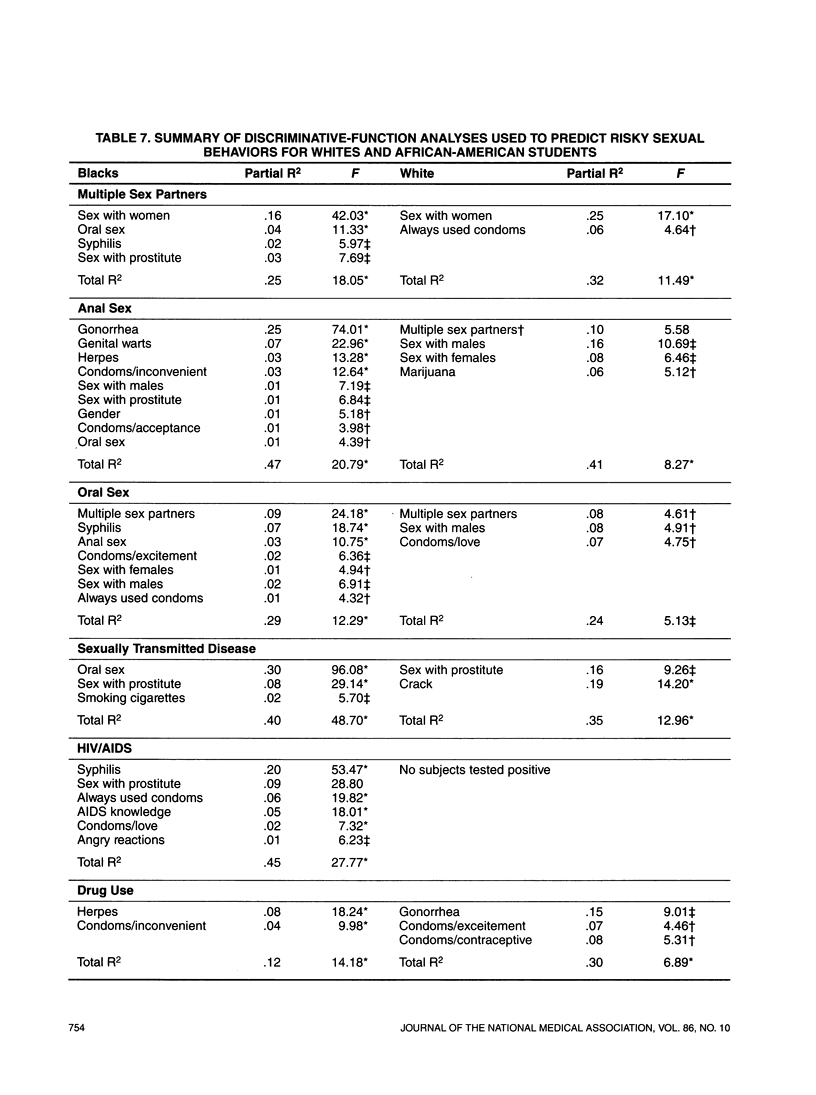
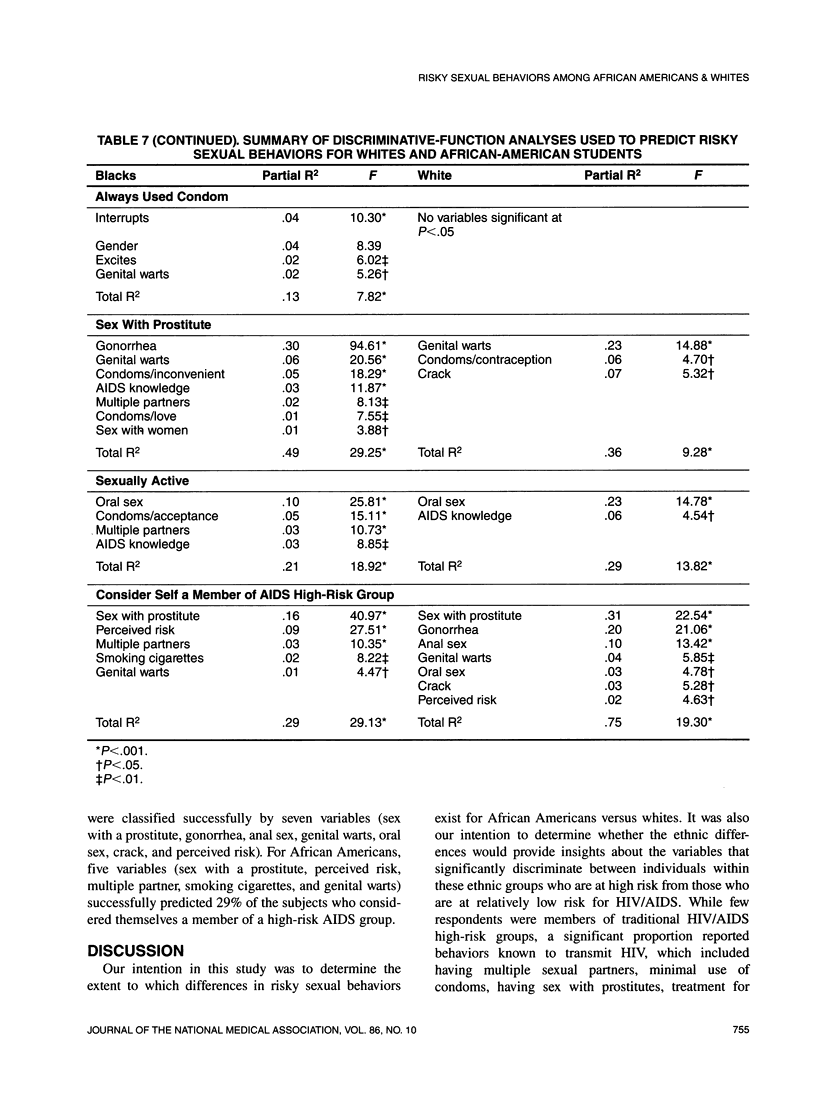
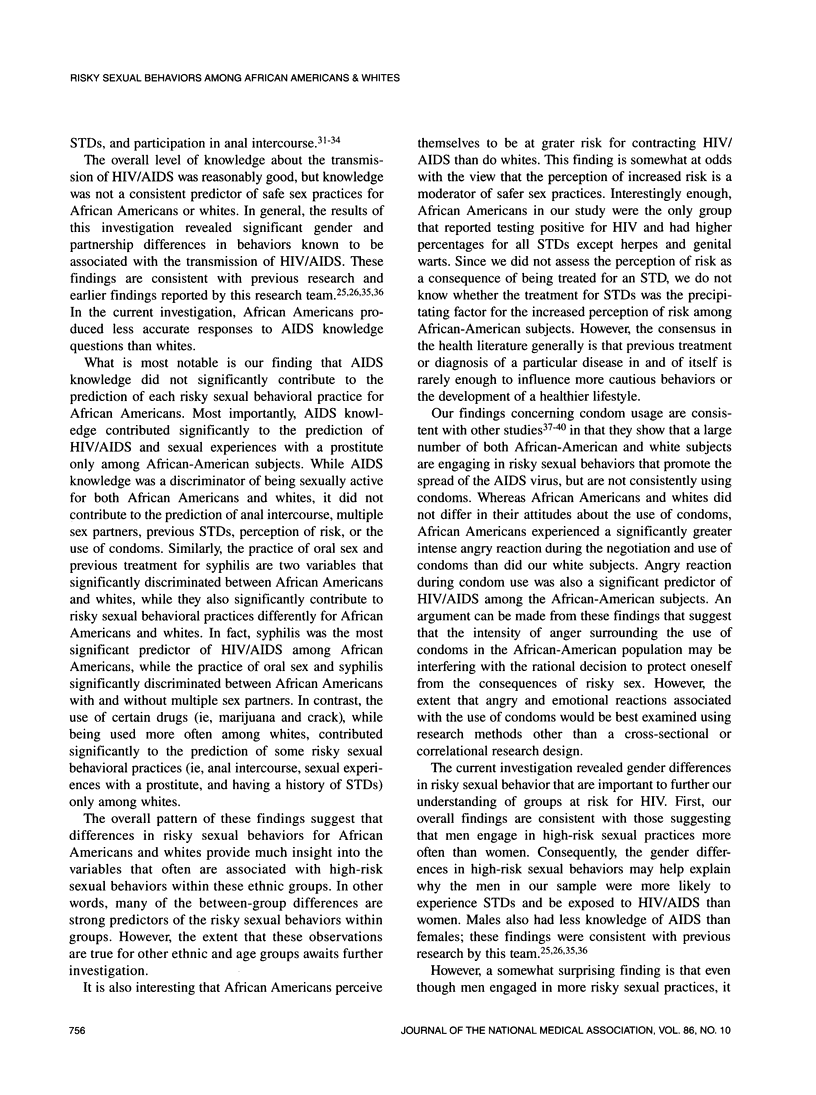
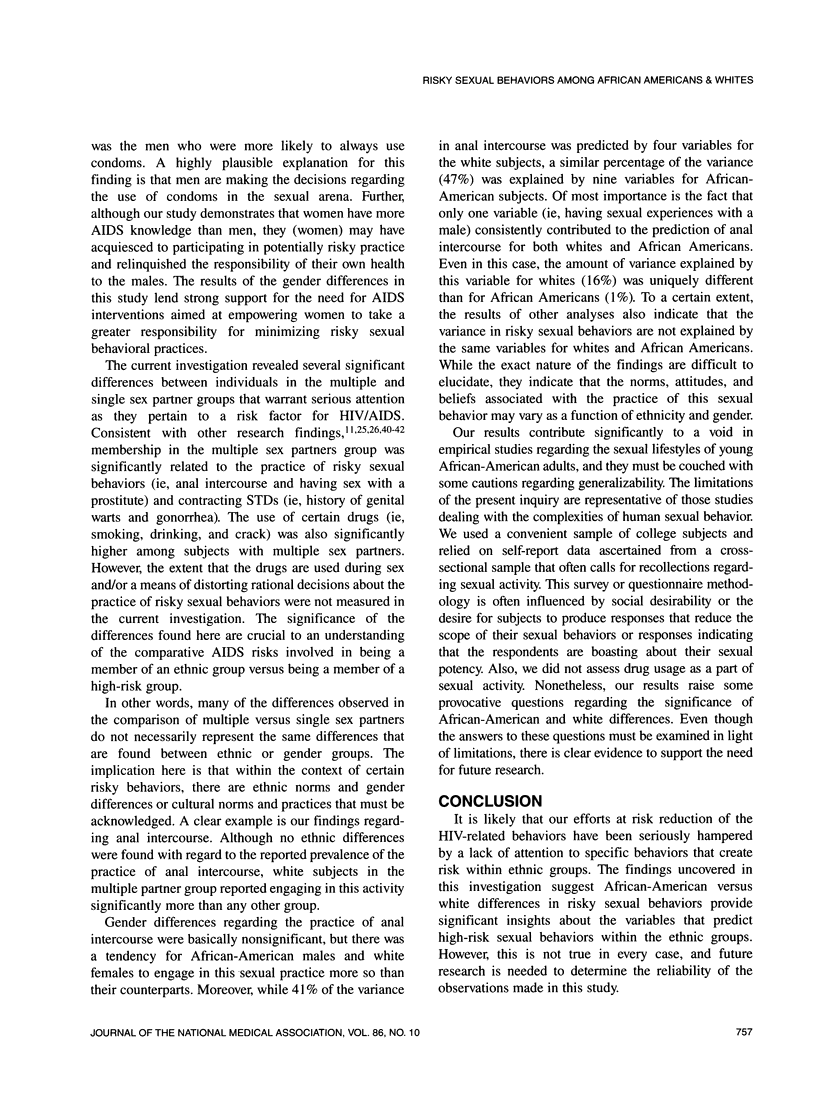
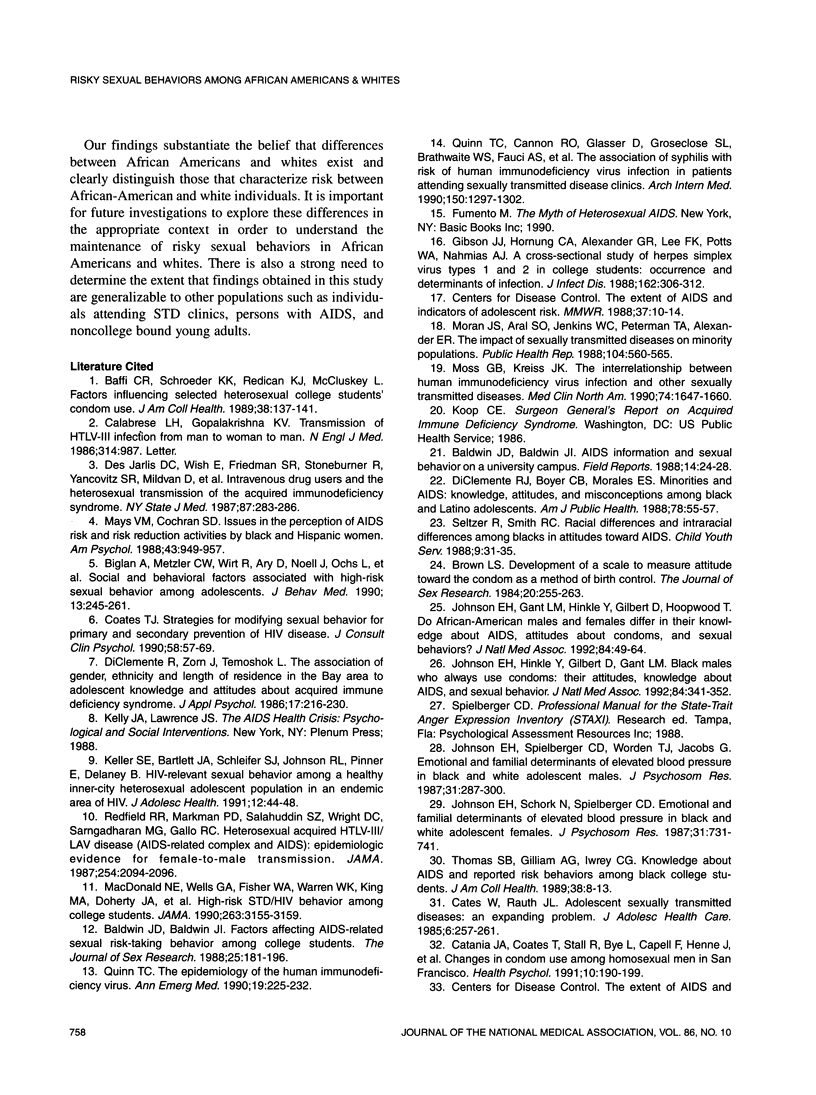
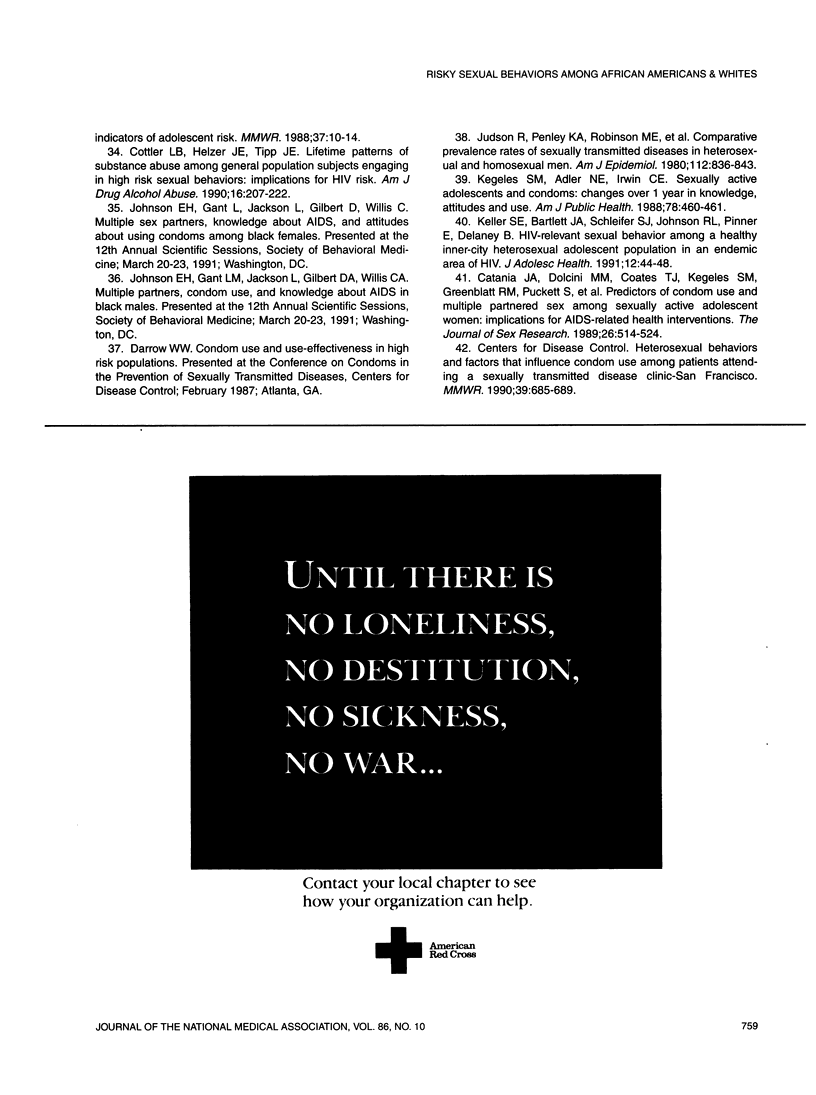
Selected References
These references are in PubMed. This may not be the complete list of references from this article.
- Baffi C. R., Schroeder K. K., Redican K. J., McCluskey L. Factors influencing selected heterosexual male college students' condom use. J Am Coll Health. 1989 Nov;38(3):137–141. doi: 10.1080/07448481.1989.9938432. [DOI] [PubMed] [Google Scholar]
- Biglan A., Metzler C. W., Wirt R., Ary D., Noell J., Ochs L., French C., Hood D. Social and behavioral factors associated with high-risk sexual behavior among adolescents. J Behav Med. 1990 Jun;13(3):245–261. doi: 10.1007/BF00846833. [DOI] [PubMed] [Google Scholar]
- Calabrese L. H., Gopalakrishna K. V. Transmission of HTLV-III infection from man to woman to man. N Engl J Med. 1986 Apr 10;314(15):987–987. doi: 10.1056/nejm198604103141510. [DOI] [PubMed] [Google Scholar]
- Catania J. A., Coates T. J., Stall R., Bye L., Kegeles S. M., Capell F., Henne J., McKusick L., Morin S., Turner H. Changes in condom use among homosexual men in San Francisco. Health Psychol. 1991;10(3):190–199. doi: 10.1037//0278-6133.10.3.190. [DOI] [PubMed] [Google Scholar]
- Centers for Disease Control (CDC) Heterosexual behaviors and factors that influence condom use among patients attending a sexually transmitted disease clinic--San Francisco. MMWR Morb Mortal Wkly Rep. 1990 Oct 5;39(39):685–689. [PubMed] [Google Scholar]
- Coates T. J. Strategies for modifying sexual behavior for primary and secondary prevention of HIV disease. J Consult Clin Psychol. 1990 Feb;58(1):57–69. doi: 10.1037//0022-006x.58.1.57. [DOI] [PubMed] [Google Scholar]
- Cottler L. B., Helzer J. E., Tipp J. E. Lifetime patterns of substance use among general population subjects engaging in high risk sexual behaviors: implications for HIV risk. Am J Drug Alcohol Abuse. 1990;16(3-4):207–222. doi: 10.3109/00952999009001584. [DOI] [PubMed] [Google Scholar]
- Des Jarlais D. C., Wish E., Friedman S. R., Stoneburner R., Yancovitz S. R., Mildvan D., el-Sadr W., Brady E., Cuadrado M. Intravenous drug use and the heterosexual transmission of the human immunodeficiency virus. Current trends in New York City. N Y State J Med. 1987 May;87(5):283–286. [PubMed] [Google Scholar]
- DiClemente R. J., Boyer C. B., Morales E. S. Minorities and AIDS: knowledge, attitudes, and misconceptions among black and Latino adolescents. Am J Public Health. 1988 Jan;78(1):55–57. doi: 10.2105/ajph.78.1.55. [DOI] [PMC free article] [PubMed] [Google Scholar]
- Johnson E. H., Gant L., Hinkle Y. A., Gilbert D., Willis C., Hoopwood T. Do African-American men and women differ in their knowledge about AIDS, attitudes about condoms, and sexual behaviors? J Natl Med Assoc. 1992 Jan;84(1):49–64. [PMC free article] [PubMed] [Google Scholar]
- Johnson E. H., Hinkle Y., Gilbert D., Gant L. M. Black males who always use condoms: their attitudes, knowledge about AIDS, and sexual behavior. J Natl Med Assoc. 1992 Apr;84(4):341–352. [PMC free article] [PubMed] [Google Scholar]
- Johnson E. H., Schork N. J., Spielberger C. D. Emotional and familial determinants of elevated blood pressure in black and white adolescent females. J Psychosom Res. 1987;31(6):731–741. doi: 10.1016/0022-3999(87)90022-5. [DOI] [PubMed] [Google Scholar]
- Judson F. N., Penley K. A., Robinson M. E., Smith J. K. Comparative prevalence rates of sexually transmitted diseases in heterosexual and homosexual men. Am J Epidemiol. 1980 Dec;112(6):836–843. doi: 10.1093/oxfordjournals.aje.a113056. [DOI] [PubMed] [Google Scholar]
- Kegeles S. M., Adler N. E., Irwin C. E., Jr Sexually active adolescents and condoms: changes over one year in knowledge, attitudes and use. Am J Public Health. 1988 Apr;78(4):460–461. doi: 10.2105/ajph.78.4.460. [DOI] [PMC free article] [PubMed] [Google Scholar]
- Keller S. E., Bartlett J. A., Schleifer S. J., Johnson R. L., Pinner E., Delaney B. HIV-relevant sexual behavior among a healthy inner-city heterosexual adolescent population in an endemic area of HIV. J Adolesc Health. 1991 Jan;12(1):44–48. doi: 10.1016/0197-0070(91)90040-s. [DOI] [PubMed] [Google Scholar]
- Keller S. E., Bartlett J. A., Schleifer S. J., Johnson R. L., Pinner E., Delaney B. HIV-relevant sexual behavior among a healthy inner-city heterosexual adolescent population in an endemic area of HIV. J Adolesc Health. 1991 Jan;12(1):44–48. doi: 10.1016/0197-0070(91)90040-s. [DOI] [PubMed] [Google Scholar]
- MacDonald N. E., Wells G. A., Fisher W. A., Warren W. K., King M. A., Doherty J. A., Bowie W. R. High-risk STD/HIV behavior among college students. JAMA. 1990 Jun 20;263(23):3155–3159. [PubMed] [Google Scholar]
- Mays V. M., Cochran S. D. Issues in the perception of AIDS risk and risk reduction activities by black and Hispanic/Latina women. Am Psychol. 1988 Nov;43(11):949–957. doi: 10.1037//0003-066x.43.11.949. [DOI] [PMC free article] [PubMed] [Google Scholar]
- Moran J. S., Aral S. O., Jenkins W. C., Peterman T. A., Alexander E. R. The impact of sexually transmitted diseases on minority populations. Public Health Rep. 1989 Nov-Dec;104(6):560–565. [PMC free article] [PubMed] [Google Scholar]
- Moss G. B., Kreiss J. K. The interrelationship between human immunodeficiency virus infection and other sexually transmitted diseases. Med Clin North Am. 1990 Nov;74(6):1647–1660. doi: 10.1016/s0025-7125(16)30500-4. [DOI] [PubMed] [Google Scholar]
- Quinn T. C., Cannon R. O., Glasser D., Groseclose S. L., Brathwaite W. S., Fauci A. S., Hook E. W., 3rd The association of syphilis with risk of human immunodeficiency virus infection in patients attending sexually transmitted disease clinics. Arch Intern Med. 1990 Jun;150(6):1297–1302. [PubMed] [Google Scholar]
- Quinn T. C. The epidemiology of the human immunodeficiency virus. Ann Emerg Med. 1990 Mar;19(3):225–232. doi: 10.1016/s0196-0644(05)82035-9. [DOI] [PubMed] [Google Scholar]


